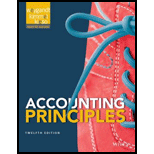
Concept explainers
(a)
Perpetual Inventory System: Perpetual Inventory System refers to the inventory system that maintains the detailed records of every inventory transactions related to purchases and sales on a continuous basis. It shows the exact on-hand-inventory at any point of time.
Periodic Inventory System: It is a system in which the inventory is updated in the accounting records on a periodic basis such as at the end of each month, quarter or year. In other words, it is an accounting method which is used to determine the amount of inventory at the end of each accounting period.
Inventory cost flow: It refers to the flow (movement) of inventory when it is purchased or sell by the business organization.
The various inventory cost flow methods are:
- First-in, first-out (FIFO)
- Last in, first-out (LIFO)
- Average-cost
FIFO method: In FIFO method, those goods are sold first which are purchased first by the business organization.
LIFO method: In LIFO method, those goods are sold first which are purchased in last by the business organization
Average-cost method: In average-cost method, the value of inventory is calculated by the average of cost of goods sold which are available for the sale purpose for that period.
To determine: The amount of ending inventory under FIFO, LIFO, and Moving-average cost.
(b)
Compare results of part (a) with results of E6-4.
(c)
The method which will provide same amount of ending inventory under periodic and perpetual inventory system, and the method which will provide different ending inventory under both inventory system.
Want to see the full answer?
Check out a sample textbook solution
Chapter 6 Solutions
Accounting Principles - Standalone book
- Please show me the correct way to solve this financial accounting problem with accurate methods.arrow_forwardI need assistance with this financial accounting problem using valid financial procedures.arrow_forwardI need assistance with this financial accounting question using appropriate principles.arrow_forward
- Department B had 12,000 units in work in process that were 75% completed as to labor and overhead at the beginning of the period; 52,400 units of direct materials were added during the period; 48,000 units were completed during the period, and 9,500 units were 60% completed as to labor and overhead at the end of the period. All materials are added at the beginning of the process. The first-in, first-out method is used to cost inventories. The number of equivalent units of production for conversion costs for the period was ____ Units.arrow_forwardCan you help me solve this general accounting problem with the correct methodology?arrow_forwardPlease explain the correct approach for solving this general accounting question.arrow_forward

 AccountingAccountingISBN:9781337272094Author:WARREN, Carl S., Reeve, James M., Duchac, Jonathan E.Publisher:Cengage Learning,
AccountingAccountingISBN:9781337272094Author:WARREN, Carl S., Reeve, James M., Duchac, Jonathan E.Publisher:Cengage Learning, Accounting Information SystemsAccountingISBN:9781337619202Author:Hall, James A.Publisher:Cengage Learning,
Accounting Information SystemsAccountingISBN:9781337619202Author:Hall, James A.Publisher:Cengage Learning, Horngren's Cost Accounting: A Managerial Emphasis...AccountingISBN:9780134475585Author:Srikant M. Datar, Madhav V. RajanPublisher:PEARSON
Horngren's Cost Accounting: A Managerial Emphasis...AccountingISBN:9780134475585Author:Srikant M. Datar, Madhav V. RajanPublisher:PEARSON Intermediate AccountingAccountingISBN:9781259722660Author:J. David Spiceland, Mark W. Nelson, Wayne M ThomasPublisher:McGraw-Hill Education
Intermediate AccountingAccountingISBN:9781259722660Author:J. David Spiceland, Mark W. Nelson, Wayne M ThomasPublisher:McGraw-Hill Education Financial and Managerial AccountingAccountingISBN:9781259726705Author:John J Wild, Ken W. Shaw, Barbara Chiappetta Fundamental Accounting PrinciplesPublisher:McGraw-Hill Education
Financial and Managerial AccountingAccountingISBN:9781259726705Author:John J Wild, Ken W. Shaw, Barbara Chiappetta Fundamental Accounting PrinciplesPublisher:McGraw-Hill Education





